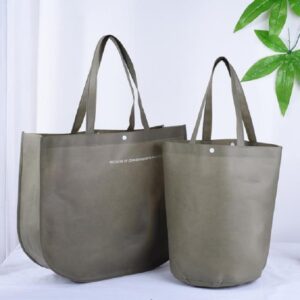The production of nonwoven shopping bags, like any manufacturing process, comes with environmental considerations. Here are some factors to consider:
- Raw Material Source: Nonwoven fabrics are commonly made from synthetic materials such as polypropylene or polyester. The production of these materials often involves the extraction and processing of fossil fuels, which can have environmental impacts such as habitat destruction, air and water pollution, and greenhouse gas emissions.
- Energy Consumption: The manufacturing process of nonwoven fabrics requires energy for heating, melting, and bonding the fibers. Depending on the energy source used (e.g., fossil fuels, renewable energy), this can contribute to greenhouse gas emissions and other environmental impacts. Energy-efficient production methods and the use of renewable energy sources can help mitigate these impacts.
- Chemical Usage: Some nonwoven fabric production processes may involve the use of chemicals for fiber treatment, bonding, or finishing. These chemicals can include additives, solvents, or dyes, which may have environmental implications if not properly managed. Efforts to minimize chemical usage, optimize chemical processes, and implement proper waste management and disposal practices are essential to reduce environmental harm.
- Water Usage: Water is used in various stages of nonwoven fabric production, including fiber processing, nonwoven shopping bags supplier cleaning, and finishing. Depending on the production methods and practices, water usage can contribute to water scarcity, pollution, and habitat degradation. Implementing water conservation measures, recycling and treating wastewater, and using water-efficient technologies can help mitigate these impacts.
- Waste Generation: Nonwoven fabric production can generate waste materials such as offcuts, scraps, and packaging. Proper waste management practices, including recycling, reuse, and responsible disposal, are essential to minimize the environmental impact of waste generation. Additionally, efforts to design products for recyclability or biodegradability can help reduce waste accumulation.
- End-of-Life Management: At the end of their life cycle, nonwoven shopping bags may end up in landfills, where they can contribute to environmental pollution and take a long time to degrade. Promoting reuse, recycling, or composting of nonwoven shopping bags can help extend their lifespan and reduce their environmental footprint.
Overall, addressing these environmental considerations requires a holistic approach that considers the entire life cycle of nonwoven shopping bags, from raw material sourcing to end-of-life management. Implementing sustainable practices, adopting eco-friendly materials and technologies, and promoting consumer awareness and behavior change are essential steps towards minimizing the environmental impact of nonwoven shopping bag production.
